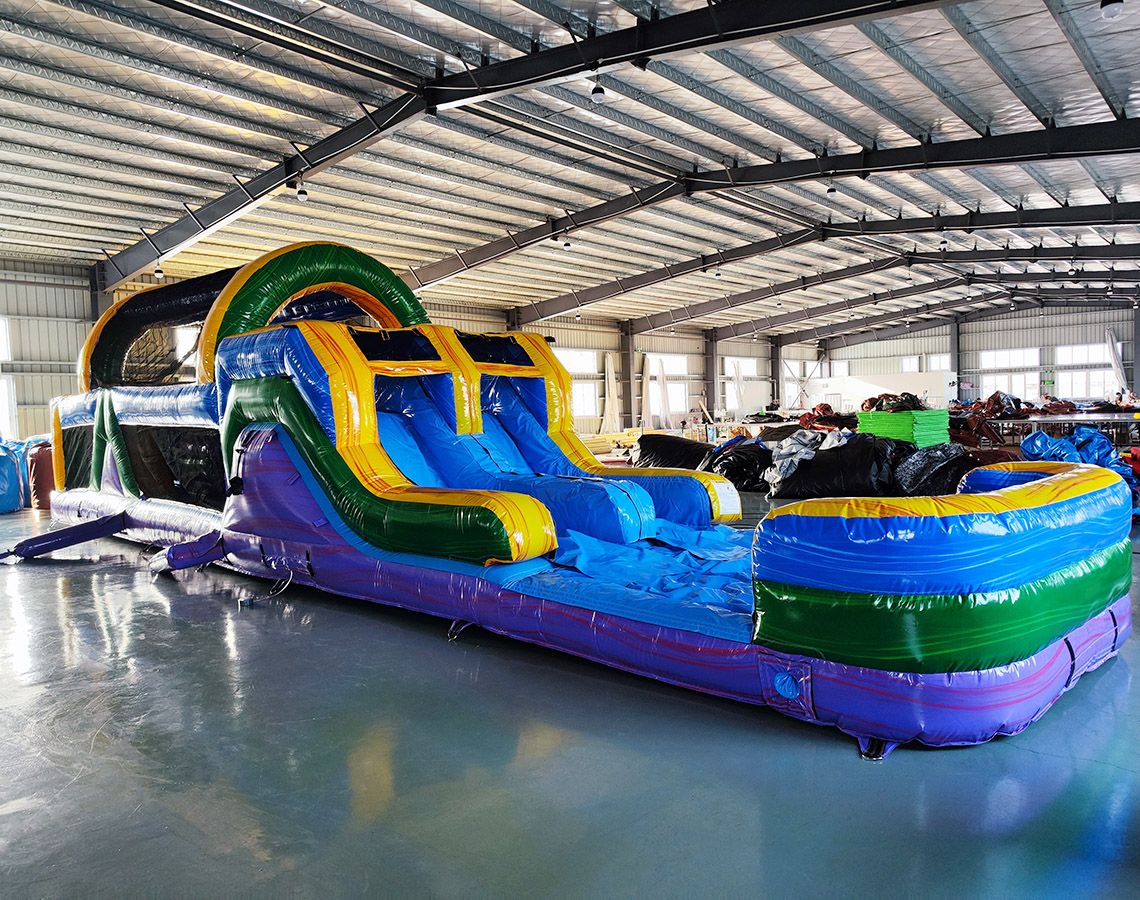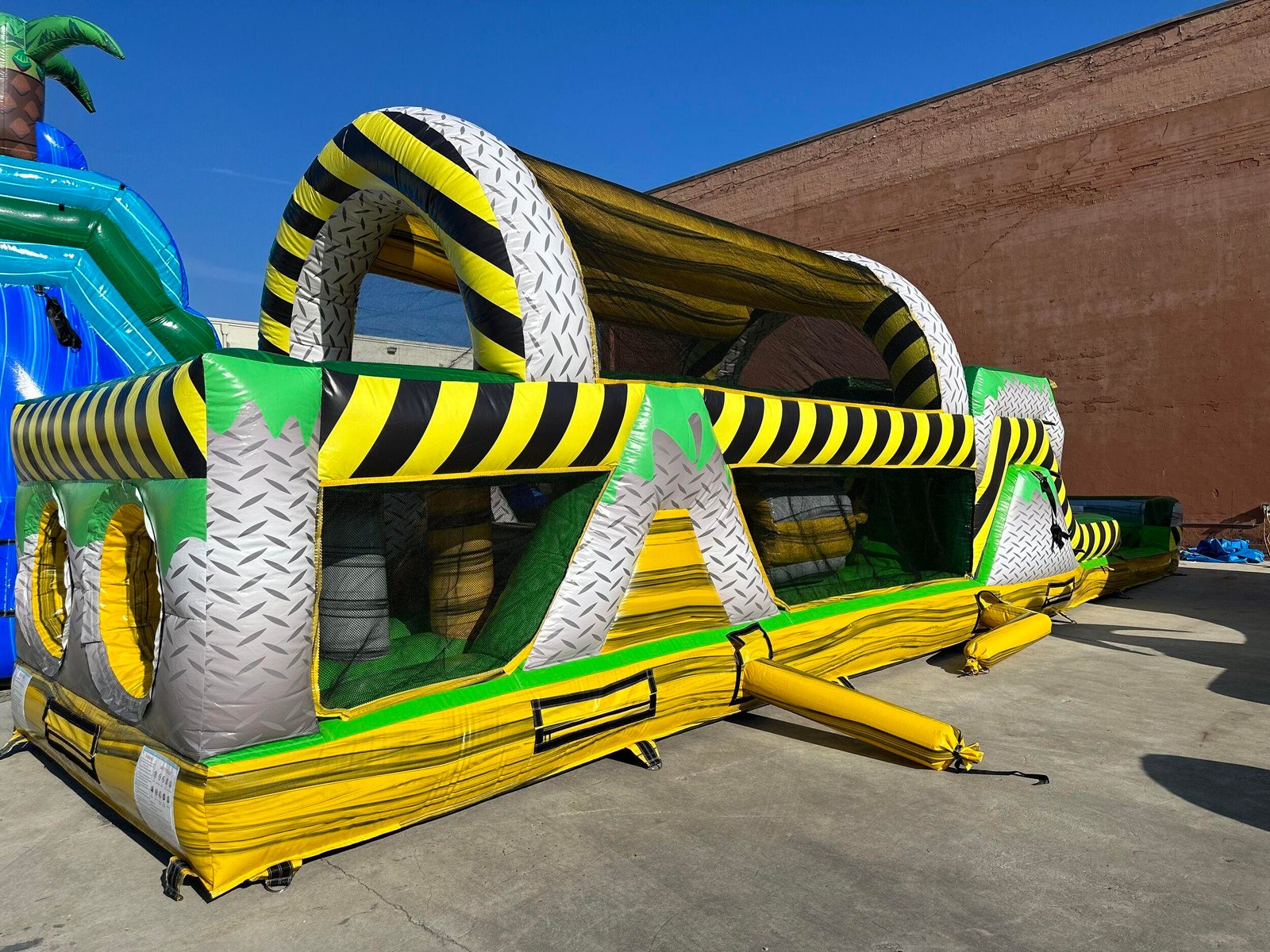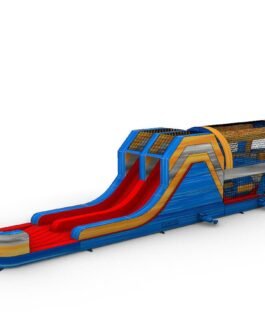Conquering the Hazardous Run: A Guide to Hybrid Obstacle Races
$3,795.00
Buy the durable 46′ Toxic Hybrid Obstacle Wet/Dry for your rental inflatable business. This colorful and thrilling obstacle course is perfect for events and parties. Get ahead of the competition now!
Description
“`html
Introduction to Hybrid Obstacle Races
Hybrid obstacle races have surged in popularity in recent years, captivating the interest of fitness enthusiasts and adrenaline seekers alike. These races are a distinctive blend of traditional running and challenging obstacles, creating a comprehensive and multifaceted test of endurance, strength, and agility. Participants navigate a course that seamlessly integrates elements from both natural terrains, such as mud pits and steep hills, and man-made structures, including wall climbs, rope swings, and cargo nets.
The allure of hybrid obstacle races lies in their demanding nature and the variety they offer. Unlike traditional runs, where the primary focus is on covering distance, hybrid obstacle races require competitors to overcome various physical and mental challenges. This fusion of activities not only breaks the monotony of long-distance running but also enhances overall fitness by engaging multiple muscle groups and improving coordination and problem-solving skills.
One of the key factors driving the rise of hybrid obstacle races is the sense of achievement they provide. Completing a race filled with formidable hurdles instills a profound sense of accomplishment and boosts self-confidence. Each obstacle conquered is a testament to one’s resilience and determination, fostering a strong sense of personal triumph. For fitness enthusiasts, these races offer an opportunity to push beyond traditional fitness routines and explore new limits.
The community aspect of hybrid obstacle races is another significant draw. Events often foster camaraderie among participants who encourage and support each other throughout the race. This supportive atmosphere helps build lasting friendships and enhances the overall experience, making it more enjoyable and fulfilling.
In essence, hybrid obstacle races represent a dynamic and challenging adventure that appeals to a wide range of individuals seeking to test their physical and mental boundaries. As the popularity of these races continues to grow, they remain a compelling choice for those looking to experience a unique and rewarding fitness challenge.
“`
Training for a Hybrid Obstacle Race
Preparing for a hybrid obstacle race requires a multifaceted approach to training that combines endurance, strength, and flexibility. Comprehensive training programs should integrate diverse types of workouts, each targeting different aspects of physical fitness crucial for obstacle course success. Endurance running forms the foundation of this regimen and involves long-distance runs to boost cardiovascular stamina. Such runs prepare athletes to handle lengthy and physically demanding courses without succumbing to fatigue.
Strength training is equally paramount. Incorporating exercises like deadlifts, squats, and pull-ups helps build the muscle required to overcome obstacles such as wall climbs, heavy carries, and rope traverses. Functional movements, which mimic everyday activities, are recommended to align training closely with race demands. For instance, practicing box jumps and kettlebell swings prepares competitors for similar race tasks, enhancing their overall performance.
Flexibility exercises shouldn’t be overlooked. Incorporating yoga and dynamic stretches into your routine boosts your range of motion and decreases the risk of injury. Flexibility is particularly important for navigating obstacles that require agility and balance. Stretching also aids in muscle recovery, promoting sustained endurance throughout the training period.
Specificity in training means tailor-fitting your regimen to include drills that simulate the types of obstacles present in the race. Practicing activities like monkey bars, tire flips, and low crawls can greatly diminish race-day surprises. Training in varied environments — rugged trails, muddy terrains, and water crossings — can further acclimatize you to the unpredictable nature of a hybrid obstacle race.
Psychological preparation is indispensable for conquering a hybrid obstacle race. Building mental toughness can be achieved through challenging workouts that test your limits and develop resilience. Strategies such as visualization techniques and positive self-talk can empower athletes to stay motivated and push through physically taxing moments.
Seasoned athletes and trainers emphasize the importance of listening to your body to avoid overtraining and injuries. Periodic rest days, proper nutrition, and hydration are critical components of a sustainable training plan. Remaining motivated is easier when setting short-term goals and celebrating small victories, providing continuous encouragement throughout the training journey.
Race Day Strategies and Tips
Preparing for a hybrid obstacle race begins long before the starting gun. On race day, the strategy extends to not just physical readiness but also optimizing performance through proper pre-race preparations. Essential to a solid start is a balanced meal rich in carbohydrates and proteins to fuel your body, ideally consumed 3-4 hours before the race. Complement this with consistent hydration; begin hydrating well in advance and maintain a steady intake of water right up to race time to ensure peak physical performance.Hazardous Run Hybrid Obstacle
An integral part of preparation is a comprehensive warm-up routine. Allocate at least 20-30 minutes for dynamic stretches and light jogging to elevate your heart rate and loosen your muscles, reducing the risk of injury. This primes your body for strenuous activities, which are a staple of obstacle races.
Pacing strategies play a crucial role in energy conservation across various segments of the race. Start by maintaining a moderate, sustainable pace, resisting the urge to sprint at the onset to avoid early fatigue. As you encounter different obstacles, like walls, mud pits, and rope climbs, it’s crucial to manage your energy output; take a moment to plan your approach, ensuring efficient and swift navigation.Hazardous Run Hybrid Obstacle
When confronted with obstacles, technique often trumps raw strength. For wall climbs, use a high knee drive to gain leverage. In mud pits, consider a crawling technique to maintain stability. For rope climbs, employ both leg and arm strength by mastering the foot-lock method, minimizing the reliance on upper body strength alone.Hazardous Run Hybrid Obstacle
For team events, the significance of teamwork and camaraderie cannot be overstated. Communication, encouragement, and strategic planning within the team enhance overall performance. Assign roles based on individual strengths and always be prepared to support your teammates during challenging obstacles, fostering a spirit of cooperation.
Adaptive resilience is vital for overcoming unexpected challenges. Maintaining a positive mindset can be the difference between triumph and defeat. Embrace each obstacle as an opportunity to test and improve your capabilities, staying flexible in your approach and solutions.
After the Race: Recovery and Reflection
Completing a hybrid obstacle race is an exhilarating achievement, but adequate recovery is essential to maintain long-term fitness and prepare for future challenges. Effective recovery practices should be a priority post-race to alleviate muscle soreness, promote healing, and restore optimal function. Start with gentle stretching exercises to maintain flexibility and prevent stiffness. Incorporate foam rolling to target tight muscle areas, enhancing blood flow and reducing muscle tension.
Adequate rest is crucial in the recovery process. Allow your body ample time to repair itself by getting sufficient sleep and avoiding strenuous activities for a few days following the race. Complement these practices with proper nutrition and hydration. Replenish glycogen stores by consuming complex carbohydrates, and include protein-rich foods to aid muscle repair. Hydrate thoroughly with water and electrolyte-rich beverages to restore fluid balance and prevent dehydration.Hazardous Run Hybrid Obstacle
Post-race reflection is equally important for personal growth and future improvement. Take time to note your performance, identifying strengths and areas where there is room for growth. Reflect on the physical and mental challenges you faced, and consider how you can train more effectively for future races. Valuable insights gained through reflection can lead to enhanced strategies and improved outcomes in subsequent events.Hazardous Run Hybrid Obstacle
Hearing from past participants can be a powerful motivator. Consider the story of Emily, who overcame significant personal struggles to complete her first hybrid obstacle race. Her journey exemplifies perseverance and determination, highlighting the profound sense of achievement and personal growth that comes with conquering a race of this nature. Testimonials like Emily’s can inspire you to push through your limits and strive for new personal bests.
Conquering a hybrid obstacle race is more than just a physical endeavor—it fosters resilience, teaches valuable life lessons, and brings lasting benefits. Embracing effective recovery methods and reflecting on your experience ensures you’re well-prepared for the next race, paving the way for continuous improvement and personal development.Hazardous Run Hybrid Obstacle







Reviews
There are no reviews yet.